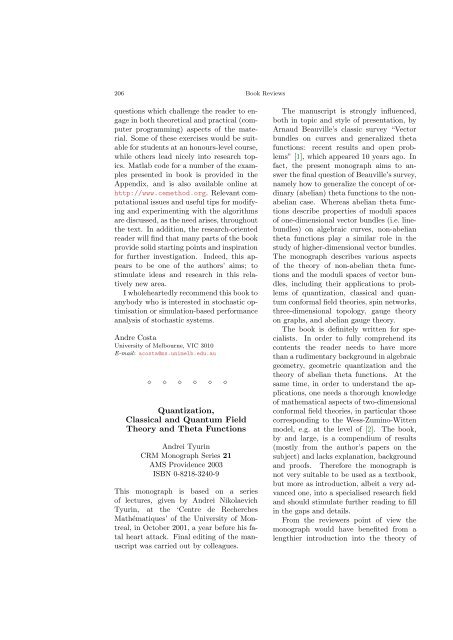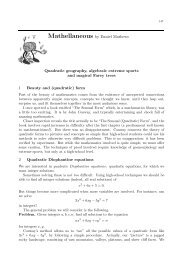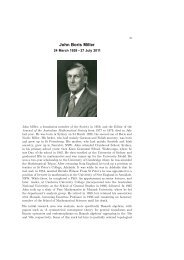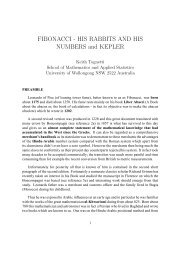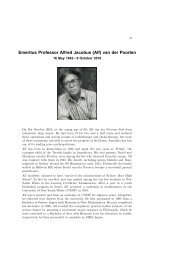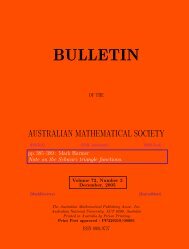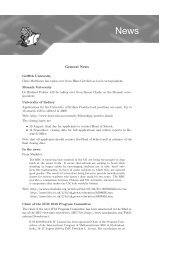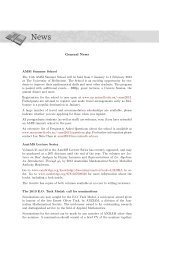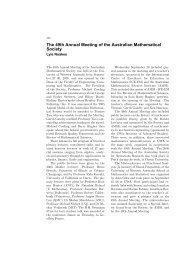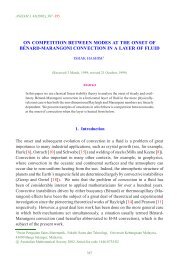Gazette 31 Vol 3 - Australian Mathematical Society
Gazette 31 Vol 3 - Australian Mathematical Society
Gazette 31 Vol 3 - Australian Mathematical Society
You also want an ePaper? Increase the reach of your titles
YUMPU automatically turns print PDFs into web optimized ePapers that Google loves.
206 Book Reviews<br />
questions which challenge the reader to engage<br />
in both theoretical and practical (computer<br />
programming) aspects of the material.<br />
Some of these exercises would be suitable<br />
for students at an honours-level course,<br />
while others lead nicely into research topics.<br />
Matlab code for a number of the examples<br />
presented in book is provided in the<br />
Appendix, and is also available online at<br />
http://www.cemethod.org. Relevant computational<br />
issues and useful tips for modifying<br />
and experimenting with the algorithms<br />
are discussed, as the need arises, throughout<br />
the text. In addition, the research-oriented<br />
reader will find that many parts of the book<br />
provide solid starting points and inspiration<br />
for further investigation. Indeed, this appears<br />
to be one of the authors’ aims; to<br />
stimulate ideas and research in this relatively<br />
new area.<br />
I wholeheartedly recommend this book to<br />
anybody who is interested in stochastic optimisation<br />
or simulation-based performance<br />
analysis of stochastic systems.<br />
Andre Costa<br />
University of Melbourne, VIC 3010<br />
E-mail: acosta@ms.unimelb.edu.au<br />
⋄ ⋄ ⋄ ⋄ ⋄ ⋄<br />
Quantization,<br />
Classical and Quantum Field<br />
Theory and Theta Functions<br />
Andrei Tyurin<br />
CRM Monograph Series 21<br />
AMS Providence 2003<br />
ISBN 0-8218-3240-9<br />
This monograph is based on a series<br />
of lectures, given by Andrei Nikolaevich<br />
Tyurin, at the ‘Centre de Recherches<br />
Mathématiques’ of the University of Montreal,<br />
in October 2001, a year before his fatal<br />
heart attack. Final editing of the manuscript<br />
was carried out by colleagues.<br />
The manuscript is strongly influenced,<br />
both in topic and style of presentation, by<br />
Arnaud Beauville’s classic survey “Vector<br />
bundles on curves and generalized theta<br />
functions: recent results and open problems”<br />
[1], which appeared 10 years ago. In<br />
fact, the present monograph aims to answer<br />
the final question of Beauville’s survey,<br />
namely how to generalize the concept of ordinary<br />
(abelian) theta functions to the nonabelian<br />
case. Whereas abelian theta functions<br />
describe properties of moduli spaces<br />
of one-dimensional vector bundles (i.e. linebundles)<br />
on algebraic curves, non-abelian<br />
theta functions play a similar role in the<br />
study of higher-dimensional vector bundles.<br />
The monograph describes various aspects<br />
of the theory of non-abelian theta functions<br />
and the moduli spaces of vector bundles,<br />
including their applications to problems<br />
of quantization, classical and quantum<br />
conformal field theories, spin networks,<br />
three-dimensional topology, gauge theory<br />
on graphs, and abelian gauge theory.<br />
The book is definitely written for specialists.<br />
In order to fully comprehend its<br />
contents the reader needs to have more<br />
than a rudimentary background in algebraic<br />
geometry, geometric quantization and the<br />
theory of abelian theta functions. At the<br />
same time, in order to understand the applications,<br />
one needs a thorough knowledge<br />
of mathematical aspects of two-dimensional<br />
conformal field theories, in particular those<br />
corresponding to the Wess-Zumino-Witten<br />
model, e.g. at the level of [2]. The book,<br />
by and large, is a compendium of results<br />
(mostly from the author’s papers on the<br />
subject) and lacks explanation, background<br />
and proofs. Therefore the monograph is<br />
not very suitable to be used as a textbook,<br />
but more as introduction, albeit a very advanced<br />
one, into a specialised research field<br />
and should stimulate further reading to fill<br />
in the gaps and details.<br />
From the reviewers point of view the<br />
monograph would have benefited from a<br />
lengthier introduction into the theory of


